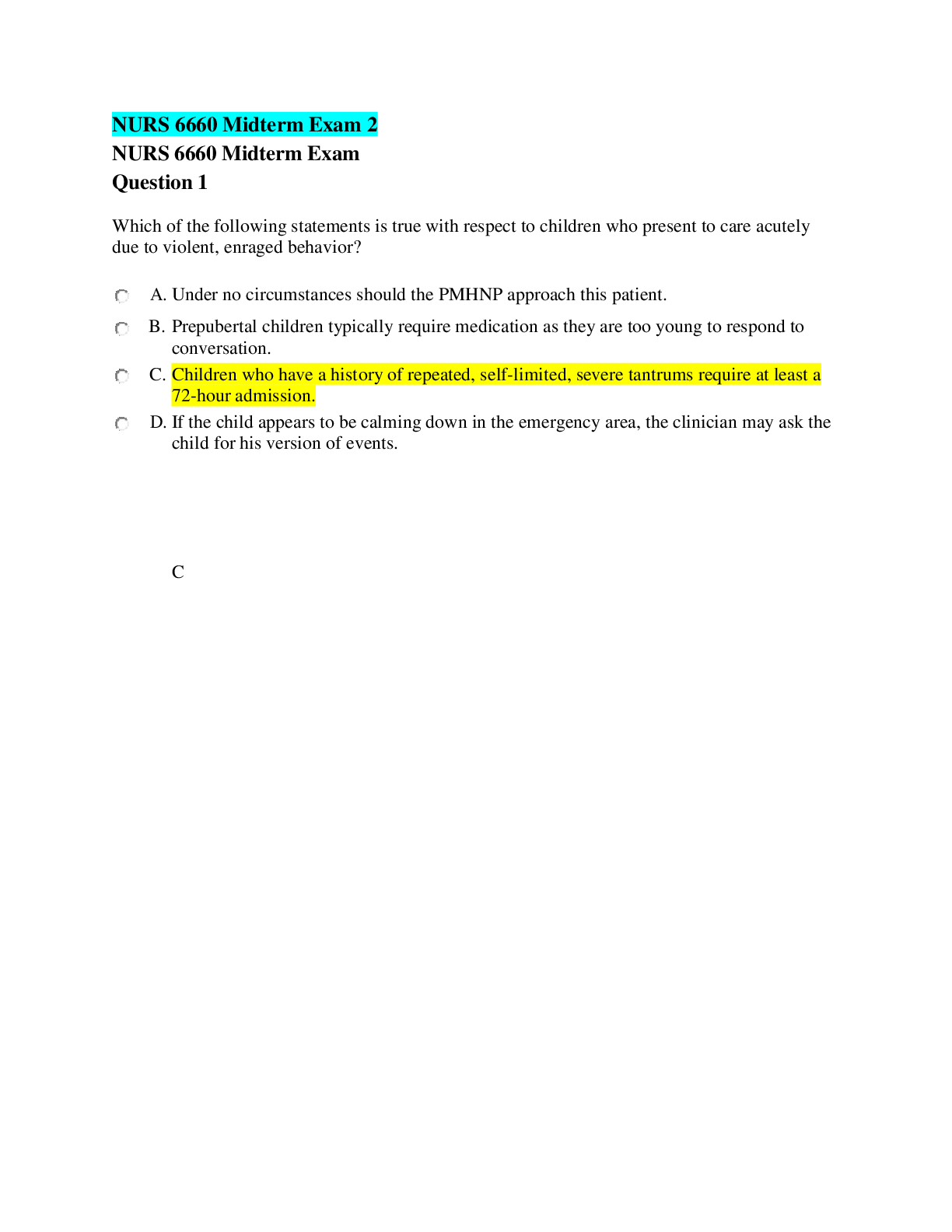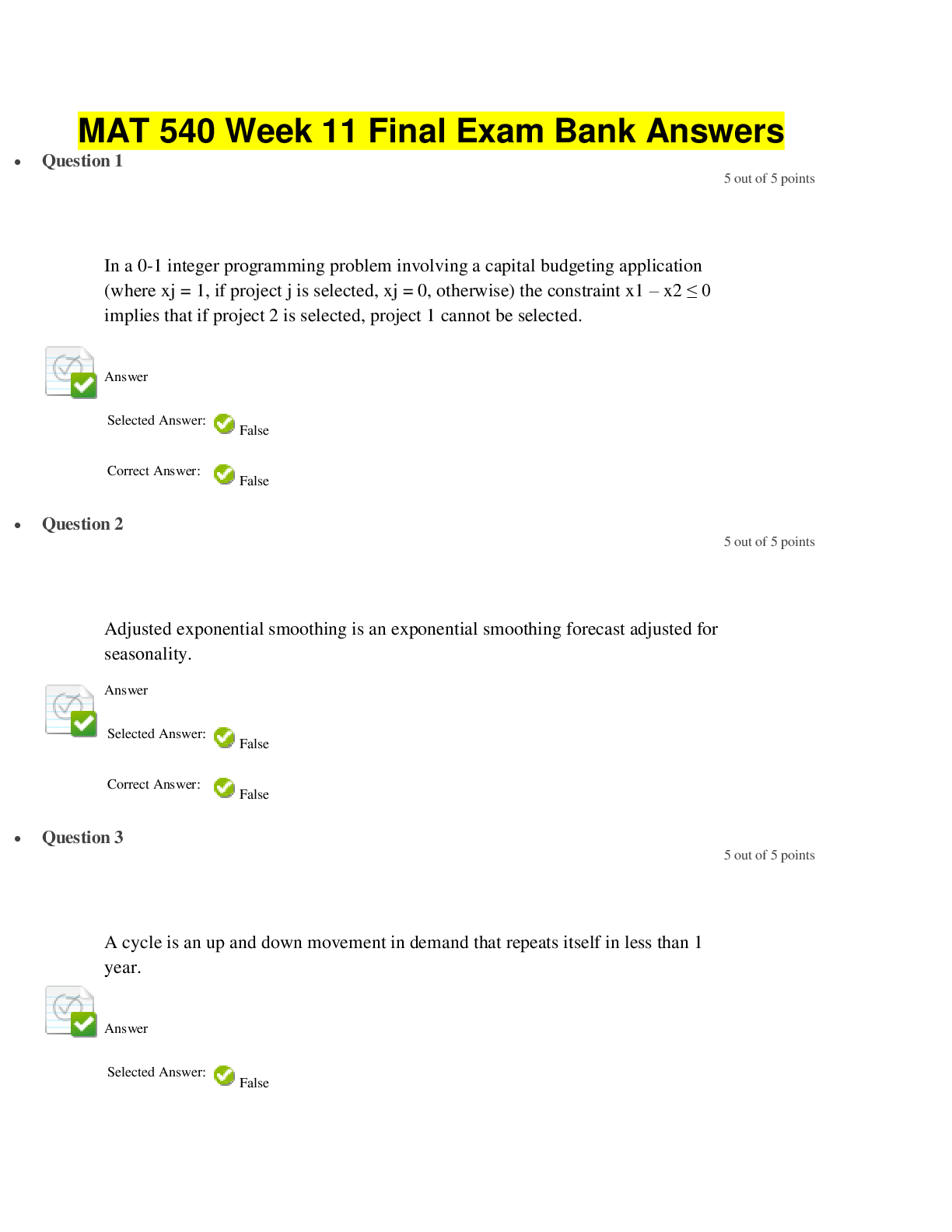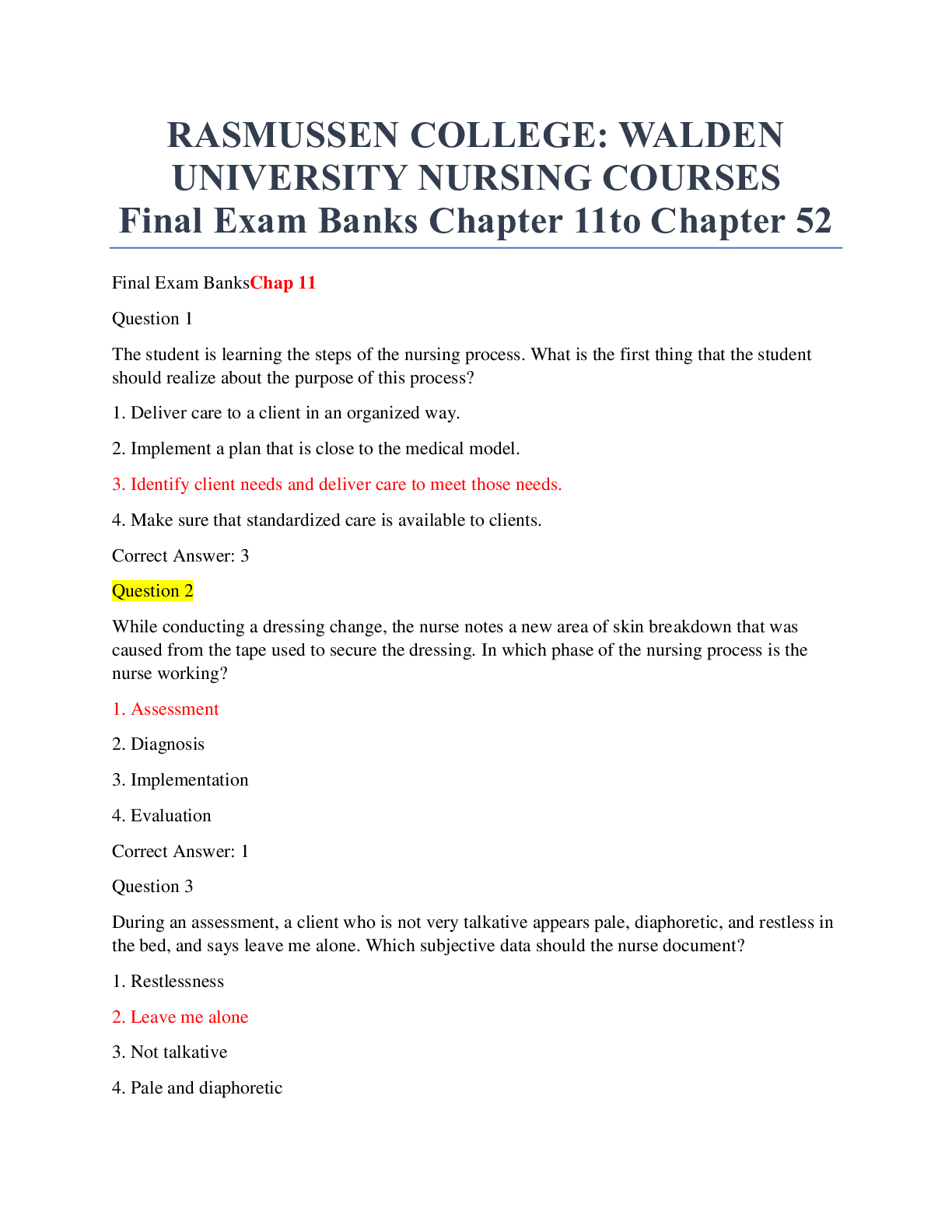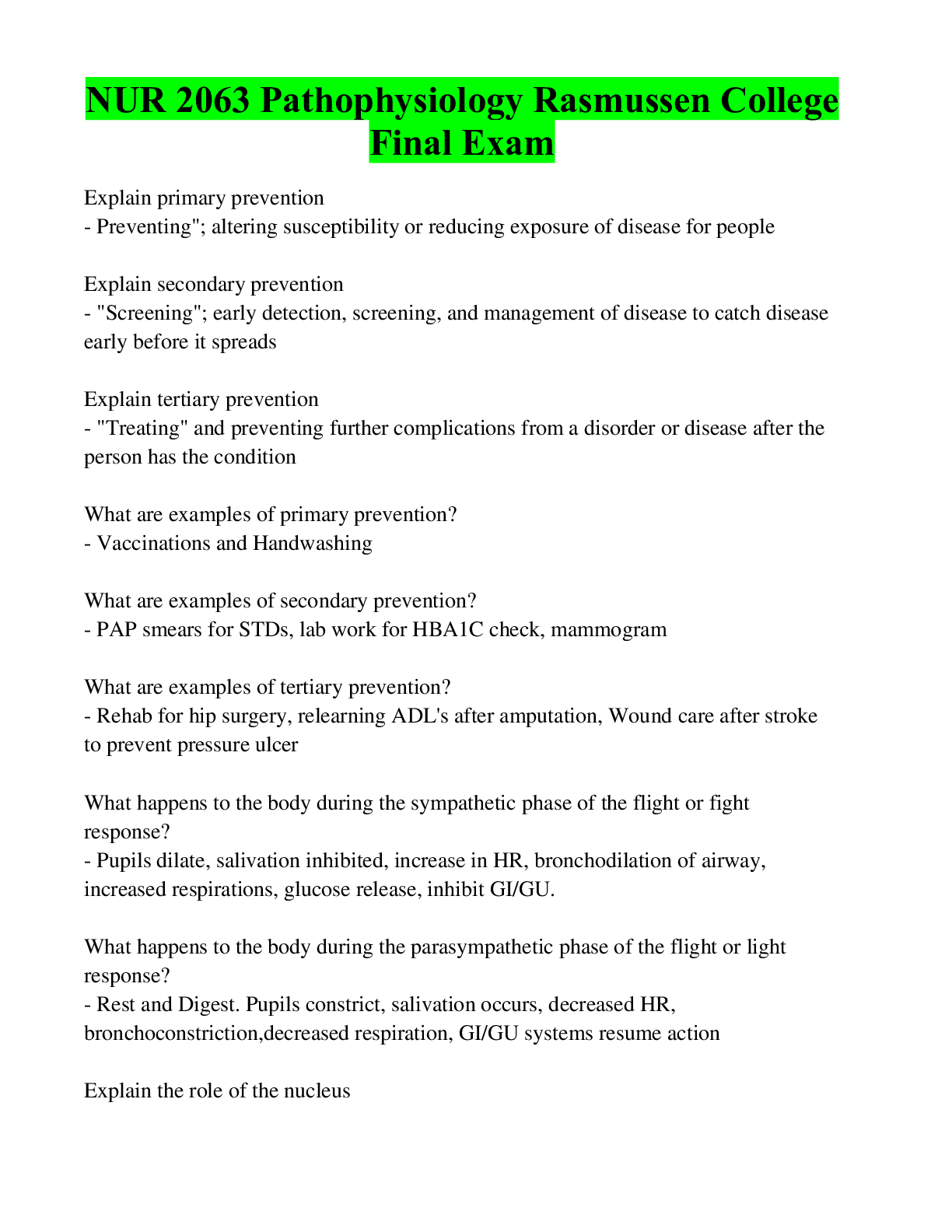Mathematics > EXAM > MAT 543 Final Exam Bank | Answered & Updated. (All)
MAT 543 Final Exam Bank | Answered & Updated.
Document Content and Description Below
MAT 543 Final Exam • Question 1 Decisions are influenced scientifically by what? • Question 2 What is an example of a non-monetary decision payoff for a health care pr... ofessional? • Question 3 Which is an example related to a part of a decision that is not within the decision maker's control? • Question 4 What are the most important aspects resulting from a decision made in the health care industry? • Question 5 If service times are clustered about one number and look symmetric, how large of a sample may be sufficient as a basis for estimating mean service time? • Question 6 Which method to determine costs involves tracking individuals through intervention? • Question 7 How is the cost-effectiveness of an intervention defined? • Question 8 Which formula calculates costs in a time period? • Question 9 What is true about all activities? • Question 10 What does TSPR stand for? • Question 11 What is a key aspect of a project? • Question 12 What does PERT analysis allow managers to do regarding the use of slack? • Question 13 Harris Health is considering the development of a new ambulatory care service. The project will cost $500,000 to implement and have a useful life of five years. At the conclusion of the project’s useful life, equipment associated with the project can be sold for $45,000. Over the five years of operation, incremental revenue attributed to the project will be $180,000 annually, while incremental expenses annually will be $48,000. The organization is also considering an alternative project of similar risk and time horizon, which has a rate of return equal to 4.5%. What is the project’s net present value (NPV)? • Question 14 How is a hurdle rate used in practice inside of an organization? • Question 15 A specific investment provides an opportunity for the following stream of cash flows: Year CY+ 1 through CY + 5: $40,000 per year, years CY+6 through CY+10: $25,000 per year, year CY+11: $5,000. Assume a discount rate of 4%. What should you be willing to pay for this investment? Solve the problem by taking advantage of the imbedded annuity in the future cash flows. • Question 16 Harris Health is considering the development of a new ambulatory care service. The project will cost $500,000 to implement and have a useful life of five years. At the conclusion of the project’s useful life, equipment associated with the project can be sold for $45,000. Over the five years of operation, incremental revenue attributed to the project will be $180,000 annually, while incremental expenses annually will be $48,000. The organization is also considering an alternative project of similar risk and time horizon which has a rate of return equal to 4.5%. What is the project’s computed internal rate of return (IRR)? • Question 17 What is the first step in quality analysis? • Question 18 Which chart is used to illustrate patterns of data collected over time and is intended to indicate patterns? • Question 19 Which chart is used to describe process, system, and how the system works? • Question 20 Which quality analysis technique is used to specifically create group consensus? • Question 21 Which external factor in healthcare strategic planning is concerned with total population size and population by age? • Question 22 Which type of planning focuses on organizational aspects spanning a one-year time period? • Question 23 Based on the data in the chart, what is the primary service area for Hospital A? Community Hospital A Hospital B Hospital C Hospital D West 14.65% 3.19 63.29 18.87% East 17.93 3.23 56.31 22.53 North 9.68 12.32 14.74 63.27 South 4.94 48.00 9.45 37.61 Central 10.15 6.83 30.45 52.56 Upper 5.67 56.92 8.62 28.80 Lower 44.39 1.24 25.36 29.01 • Question 24 Which type of planning focuses on resource allocation decisions to achieve goals and objectives? • Question 25 Based on the data in the chart, what is the primary service area for Hospital A? Community Hospital A Hospital B Hospital C Hospital D West 14.65% 3.19 63.29 18.87% East 17.93 3.23 56.31 22.53 North 9.68 12.32 14.74 63.27 South 4.94 48.00 9.45 37.61 Central 10.15 6.83 30.45 52.56 Upper 5.67 56.92 8.62 28.80 Lower 44.39 1.24 25.36 29.01 • Question 1 Which is an example of using relevant information for the purpose of determining the potential payoff of a decision? • Question 2 What is an example of a non-monetary decision payoff for a health care professional? • Question 3 Analytical decision-making can be depicted in which type of pictorial format? • Question 4 The probability of a decision’s possibility must always add up to what? • Question 5 A manager is mistaken to implement which action before fully evaluating the start of a new project? • Question 6 Which method to determine costs is considered the least accurate way to collect information? • Question 7 Which method to determine costs involves tracking individuals through intervention? • Question 8 Which method to determine costs involves using a provider-based approach? • Question 9 PERT has multi-system applications for projects of what scale? • Question 10 What is known as the difference between the earliest and latest start times for an activity? • Question 11 What does TSPR stand for? • Question 12 To understand and estimate project tasks and predecessor activities, what should managers do? • Question 13 Harris Health is considering the development of a new ambulatory care service. The project will cost $500,000 to implement and have a useful life of five years. At the conclusion of the project’s useful life, equipment associated with the project can be sold for $45,000. Over the five years of operation, incremental revenue attributed to the project will be $180,000 annually, while incremental expenses annually will be $48,000. The organization is also considering an alternative project of similar risk and time horizon, which has a rate of return equal to 4.5%. What is the project’s net present value (NPV)? • Question 14 Harris Health is considering the development of a new ambulatory care service. The project will cost $500,000 to implement and have a useful life of five years. At the conclusion of the project’s useful life, equipment associated with the project can be sold for $45,000. Over the five years of operation, incremental revenue attributed to the project will be $180,000 annually, while incremental expenses annually will be $48,000. The organization is also considering an alternative project of similar risk and time horizon which has a rate of return equal to 4.5%. Assume Harris Health has a hurdle rate of 7% for projects of this type. From a financial perspective, should Harris pursue the project? • Question 15 What is meant by an organization’s hurdle rate? • Question 16 Harris Health is considering the development of a new ambulatory care service. The project will cost $500,000 to implement and have a useful life of five years. At the conclusion of the project’s useful life, equipment associated with the project can be sold for $45,000. Over the five years of operation, incremental revenue attributed to the project will be $180,000 annually, while incremental expenses annually will be $48,000. The organization is also considering an alternative project of similar risk and time horizon which has a rate of return equal to 4.5%. What is the project’s computed internal rate of return (IRR)? • Question 17 How many categories of contributing factors are parts of a Fish Bone chart? • Question 18 What is the first step in quality analysis? • Question 19 Total Quality Management (TQM) is based on the premise that any system exhibits a natural level of what? • Question 20 Which quality analysis technique is used to specifically create group consensus? • Question 21 Based on the data in the chart, what is the primary service area for Hospital A? Community Hospital A Hospital B Hospital C Hospital D West 14.65% 3.19 63.29 18.87% East 17.93 3.23 56.31 22.53 North 9.68 12.32 14.74 63.27 South 4.94 48.00 9.45 37.61 Central 10.15 6.83 30.45 52.56 Upper 5.67 56.92 8.62 28.80 Lower 44.39 1.24 25.36 29.01 • Question 22 Which external factor in healthcare strategic planning is concerned with natal, mortality, and morbidity statistics? • Question 23 Which type of planning focuses on space issues? • Question 24 Based on the data in the chart, what is the primary service area for Hospital A? Community Hospital A Hospital B Hospital C Hospital D West 14.65% 3.19 63.29 18.87% East 17.93 3.23 56.31 22.53 North 9.68 12.32 14.74 63.27 South 4.94 48.00 9.45 37.61 Central 10.15 6.83 30.45 52.56 Upper 5.67 56.92 8.62 28.80 Lower 44.39 1.24 25.36 29.01 • Question 25 Which external factor in healthcare strategic planning is concerned with income and education level? • Question 1 Analytical decision-making can be depicted in which type of pictorial format? • Question 2 In instances where no information about the probability of the future is available, how should probabilities be set? • Question 3 Decision makers will be effective if they forgo trying to control which aspect of the decision-making process? • Question 4 What is a required component to consider for every decision? • Question 5 Which method to determine costs involves using a provider-based approach? • Question 6 How is the cost-effectiveness of an intervention defined? • Question 7 Regardless of the technique chosen to estimate provider times, what should be produced in relation to service times? • Question 8 If service times are clustered about one number and look symmetric, how large of a sample may be sufficient as a basis for estimating mean service time? • Question 9 What does TSPR stand for? • Question 10 What does PERT analysis allow managers to do regarding the use of slack? • Question 11 What is known as the difference between the earliest and latest start times for an activity? • Question 12 A health care project manager will be sorely disappointed if he holds which belief to be true once a project is finally determined? • Question 13 How is a hurdle rate used in practice inside of an organization? • Question 14 What is meant by an organization’s hurdle rate? • Question 15 How is the modified rate of return (MIRR) calculated? • Question 16 Assume a prevailing discount rate of 7%, what is the computed internal rate of return (IRR) for this series of cash flows? Year Cash Flow CY ($450,000) CY + 1 $79,000 CY + 2 $125,000 CY + 3 $140,000 CY + 4 $135,000 CY + 5 $45,000 • Question 17 Which quality analysis technique is used to specifically create group consensus? • Question 18 Which chart provides upper and lower limits that are used for examining variations to determine if system changes are needed? • Question 19 Total Quality Management (TQM) is based on the premise that any system exhibits a natural level of what? • Question 20 Which chart is used to describe process, system, and how the system works? • Question 21 Which type of planning focuses on resource allocation decisions to achieve goals and objectives? • Question 22 Which external factor in healthcare strategic planning is concerned with income and education level? • Question 23 Which external factor in healthcare strategic planning is concerned with natal, mortality, and morbidity statistics? • Question 24 Based on the data in the chart, what is the primary service area for Hospital A? Community Hospital A Hospital B Hospital C Hospital D West 14.65% 3.19 63.29 18.87% East 17.93 3.23 56.31 22.53 North 9.68 12.32 14.74 63.27 South 4.94 48.00 9.45 37.61 Central 10.15 6.83 30.45 52.56 Upper 5.67 56.92 8.62 28.80 Lower 44.39 1.24 25.36 29.01 • Question 25 Which type of planning focuses on space issues? Thursday, June 16, 2016 6:27:27 PM EDT • Question 1 Analytical decision-making can be depicted in which type of pictorial format? • Question 2 In instances where no information about the probability of the future is available, how should probabilities be set? • Question 3 Decision makers will be effective if they forgo trying to control which aspect of the decision-making process? • Question 4 What is a required component to consider for every decision? • Question 5 Which method to determine costs involves using a provider-based approach? • Question 6 How is the cost-effectiveness of an intervention defined? • Question 7 Regardless of the technique chosen to estimate provider times, what should be produced in relation to service times? • Question 8 If service times are clustered about one number and look symmetric, how large of a sample may be sufficient as a basis for estimating mean service time? • Question 9 What does TSPR stand for? • Question 10 What does PERT analysis allow managers to do regarding the use of slack? • Question 11 What is known as the difference between the earliest and latest start times for an activity? • Question 12 A health care project manager will be sorely disappointed if he holds which belief to be true once a project is finally determined? • Question 13 How is a hurdle rate used in practice inside of an organization? • Question 14 What is meant by an organization’s hurdle rate? • Question 15 How is the modified rate of return (MIRR) calculated? • Question 16 Assume a prevailing discount rate of 7%, what is the computed internal rate of return (IRR) for this series of cash flows? Year Cash Flow CY ($450,000) CY + 1 $79,000 CY + 2 $125,000 CY + 3 $140,000 CY + 4 $135,000 CY + 5 $45,000 • Question 17 Which quality analysis technique is used to specifically create group consensus? • Question 18 Which chart provides upper and lower limits that are used for examining variations to determine if system changes are needed? • Question 19 Total Quality Management (TQM) is based on the premise that any system exhibits a natural level of what? • Question 20 Which chart is used to describe process, system, and how the system works? • Question 21 Which type of planning focuses on resource allocation decisions to achieve goals and objectives? • Question 22 Which external factor in healthcare strategic planning is concerned with income and education level? • Question 23 Which external factor in healthcare strategic planning is concerned with natal, mortality, and morbidity statistics? • Question 24 Based on the data in the chart, what is the primary service area for Hospital A? Community Hospital A Hospital B Hospital C Hospital D West 14.65% 3.19 63.29 18.87% East 17.93 3.23 56.31 22.53 North 9.68 12.32 14.74 63.27 South 4.94 48.00 9.45 37.61 Central 10.15 6.83 30.45 52.56 Upper 5.67 56.92 8.62 28.80 Lower 44.39 1.24 25.36 29.01 • Question 25 Which type of planning focuses on space issues? • Question 1 What is another term for forecast? • Question 2 What is analytic forecasting useful for predicting? • Question 3 A manager who is effective with forecasting will be able to do what? • Question 4 Which assumption would guide decision making when attempting to forecast the impact of a new government regulation? • Question 5 What is the number one rule of forecasting? • Question 6 Which is one of the three guiding principles of future forecasting? • Question 7 The quantitative rationale for choosing between forecasting methods is known as what? • Question 8 Average percent change as a forecasting method relies on what primary assumption? • Question 9 If forecasting using 33 months of historical data, how many months should you forecast if using a 95% Confidence Interval? • Question 10 Which moving average best minimizes the variation in historical data and is the recommended moving average to use for forecasting? • Question 11 What is the purpose for using confidence intervals in regression forecasting? • Question 12 If forecasting using 33 months of historical data, how many months should you forecast if using a regression forecast? • Question 13 What does the y-intercept of a regression equation represent? • Question 14 What is the purpose of regression analysis? • Question 15 Which of the following is the null hypothesis used to test whether a regression line may or may not be used? • Question 16 What is true of system capacity? • Question 17 What is true of the financial breakeven point? • Question 18 The price per test is $85, and the variable cost per test is $15. What is the contribution margin per test? • Question 19 The price per test is $85, and the variable cost per test is $15. Using this information, what is the breakeven point in volume if the allocated fixed costs were $350,000? • Question 20 System capacity is created from what? • Question 21 In a single channel single server system, if the service rate is 4 per hour and the arrival rate is 6 per hours, what is the probability that a unit must wait (Pw)? • Question 22 In a single channel single server system, if the service rate is 4 per hour and the arrival rate is 6 per hours, what is the average time a unit spends waiting in the system (Wq)? • Question 23 In a single channel single server system, if the service rate is 6 per hour and the arrival rate is 4 per hour, what is the probability that a unit must wait (Pw)? • Question 24 Queuing theory calculations describe service times according to which probability distribution? • Question 25 Queuing theory calculations describe arrivals for the line according to which probability distribution? [Show More]
Last updated: 7 months ago
Preview 6 out of 36 pages

Loading document previews ...
Buy this document to get the full access instantly
Instant Download Access after purchase
Buy NowInstant download
We Accept:

Reviews( 0 )
$14.50
Can't find what you want? Try our AI powered Search
Document information
Connected school, study & course
About the document
Uploaded On
Feb 24, 2020
Number of pages
36
Written in
Additional information
This document has been written for:
Uploaded
Feb 24, 2020
Downloads
0
Views
120


















